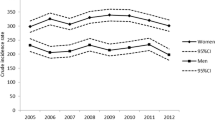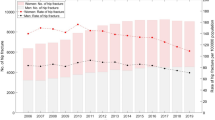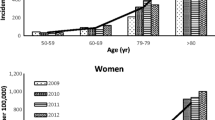Abstract
Summary
This study determined the incidence and probability of hip fractures in Poland based on verified hospital discharge notes from all of Poland. In the over-50-year-old population, hip fracture incidence was found to be 89/100,000 for men and 156/100,000 for women. Poland is among the countries with the lowest hip fracture risk in Europe.
Introduction
It is recommended that intervention thresholds should be based on an assessment of absolute fracture risk. Probability of hip fracture is calculated from the incidence of hip fracture in a given population and the incidence of death. The aim of this study was to determine the incidence and the absolute risk of hip fracture for men and women in Poland.
Methods
The study was based on National Health Fund data from all of Poland for the year 2005. Hospital discharge notes reporting an incident fracture were identified from among all those containing a matching ICD code. Lifetime and 10-year fracture probabilities were calculated taking into account the mortality risk and BMD.
Results
In 2005, there were 17,625 hip fractures diagnosed in Poland which was 30.2% less than the number of hospital discharge notes containing such a diagnosis in that year. In the over-50-year-old population, hip fracture incidence was found to be 89/100,000 for men and 165/100,000 for women. In the 50–65-year band, hip fracture incidence was higher in men than in women. The remaining lifetime probability of hip fracture at the age of 50 years was 2.0% for men and 4.5% for women which are among the lowest in Europe.
Conclusion
Hip fracture incidence and thus the probability of hip fracture risk in Poland is amongst the lowest in Europe. The authors recommend establishing a standard method for determining hip fracture incidence in a given country in order to standardize data.
Similar content being viewed by others
References
WHO Study Group (eds) (1994) Assessment of fracture risk and its application to screening for postmenopausal osteoporosis. Technical Report 843, Geneva
Marshall D, Johnell O, Wedel H (1996) Meta-analysis of how well measures of bone mineral density predict occurrence of osteoporotic fractures. Br Med J 312:1254–1259
Burger H, de Laet CE, van Daele PL et al (2000) Risk factors for increase bone loss in an elderly population: the Rotterdam Osteoporosis Study. Am J Epidemiol 147(9):871–879
Siris ES, Chen YT, Abbott TA et al (2004) Bone mineral density thresholds for pharmacological intervention to prevent fracture. Arch Intern Med 164(10):1108–1112
Kanis JA, Burlet N, Cooper C et al (2008) European guidance for the diagnosis and management of osteoporosis in postmenopausal women. Osteoporos Int 9:399–428
Kanis JA, Johnell O, Oden A et al (2008) FRAX and the assessment of fracture probability in men and women from the UK. Osteoporos Int 19:385–397
Kanis JA on behalf of the World Health Organization Scientific Group (2008) Assessment of osteoporosis at the primary health-care level. Technical report. WHO Collaborating Centre, University of Sheffield, UK
Kanis JA, Johnell O, Oden A et al (2001) Ten year risk of osteoporotic fracture and the effect of risk factors on screening strategies. Bone 30:251–258
Kanis JA, Oden A, Johnell O et al (2007) The use of clinical risk factors enhances the performance of BMD in prediction of hip fractures in men and women. Osteoporos Int 18:1033–1046
Prevention, clinical assessment and therapy of osteoporosis for women after menopause, for men after age 60. Dachverbandes der deutschsprachigen osteologischen Fachgesellschaften. (2006) (http://www.lutherhaus.de/dvo-leitlinen, accessed 4 December 2006)
Dawson-Hughes B, Tosteson AN, Melton LJ 3rd, National Osteoporosis Foundation Guide Committee et al (2008) Implications of absolute fracture risk assessment for osteoporosis practice guidelines in the USA. Osteoporos Int 9:449–458
Brown JP, Josse RG, Scientific Advisory Council of the Osteoporosis Society of Canada (2002) Clinical practice guidelines for the diagnosis and management of osteoporosis in Canada. Canadian Med Assoc Journal 167(Suppl.):1–22
Kanis JA, Johnell O, Oden A et al (2005) Intervention threshold for osteoporosis in men and women: a study based on data from Sweden. Osteoporos Int 16:6–14
Johnell O, Gullberg B, Allander E et al (1992) The apparent incidence of hip fracture in Europe: a study of national register sources. Osteoporos Int 2:298–302
Kanis JA, Johnell O, De Laet C et al (2002) International variations in hip fracture probabilities: implications for risk assessment. J Bone Miner Res 17:1239–1244
Roszkowska H, Goryński P, Wojtyniak B (1998) Hospitalizacja z powodu złamania szyjki kości udowej w Polsce w latach 1979–1995 wg płci, wieku i miejsca zamieszkania. Postepy Osteoartrologii 10:150–156
Jaworski M, Lorenc RS (2007) Risk of hip fracture in Poland. Med Sci Monit 13:206–210
Johnell O, Kanis JA, Oden A et al (2005) Predictive value of BMD for hip and other fractures. J Bone Miner Res 20(7):1185–1194
Kanis JA, Johnell O, Oden A et al (2000) Long term risk of osteoporotic fracture in Malmo. Osteoporos Int 11:669–674
Schwartz AV, Kelsey JL, Maggi S et al (1999) International variation in the incidence of hip fractures: cross-national project on osteoporosis for the World Health Organization Program for Research on Aging. Osteoporos Int 9:242–253
Lonnroos E, Kautiainen H, Karppi R et al (2006) Increased incidence of hip fractures. A population based-study in Finland. Bone 39:623–627
Wildner M, Clark DE (2001) Hip fracture incidence in East and West Germany: reassessment ten years after Unification. Osteoporos Int 12:136–139
Chevalley T, Guilley E, Herrmann F et al (2007) Incidence of hip fracture over a 10-year period (1991–2000): reversal of a secular trend. Bone 40:1284–1289
Lesic A, Jarebinski M, Pekmezovic T et al (2007) Epidemiology of hip fractures in Belgrade, Serbia Montenegro, 1990–2000. Arch Orthop Trauma Surg 127:179–183
Reginster JY, Gillet P, Gosset C (2001) Secular increase in the incidence of hip fractures in Belgium between 1984 and 1996: need for a concerted public health strategy. Bull World Health Organ 79:942–946
Zingmond DS, Soohoo NF, Silverman SL (2006) The role of socioeconomic status on hip fracture. Osteoporos Int 17:1562–1568
van Staa TP, Dennison EM, Leufkens HG et al (2001) Epidemiology of fractures in England and Wales. Bone 29:517–522
Elffors I, Allander E, Kanis JA (1994) The variable incidence of hip fracture in southern Europe: the MEDOS Study. Osteoporos Int 4:253–263
Acknowledgments
We are grateful to the President of the National Health Fund in Warsaw, the Director of the Department of Reports and Analysis of the National Health Fund in Warsaw and Dariusz Dzielak for assistance in gathering data.
Conflicts of interest
None.
Author information
Authors and Affiliations
Corresponding author
Additional information
Funding
None of the authors has received or will receive any compensation in relation to this study.
Rights and permissions
About this article
Cite this article
Czerwinski, E., Kanis, J.A., Trybulec, B. et al. The incidence and risk of hip fracture in Poland. Osteoporos Int 20, 1363–1367 (2009). https://doi.org/10.1007/s00198-008-0787-8
Received:
Accepted:
Published:
Issue Date:
DOI: https://doi.org/10.1007/s00198-008-0787-8




